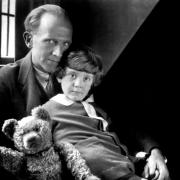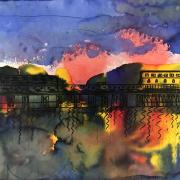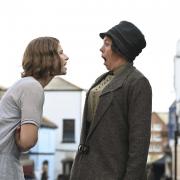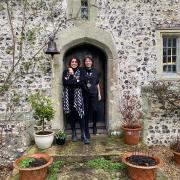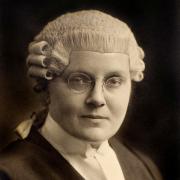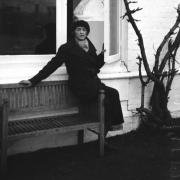Many of us will remember Hilaire Belloc for his cautionary tales for children. But this complex man held a deep and abiding love for Sussex that was regularly expressed in his poetry
Hilaire Belloc wanted to be remembered for his verse, and there is no doubt that lovers of Sussex will always associate him with the poems he wrote expressing his love for his adopted county. His verse extolling the joys of walking in the downland countryside led to him being known as the Sussex Poet Laureate. He died on 16 July 1953, after a fall at his Shipley home, and is buried at the Roman Catholic church in West Grinstead.
But 60 years after his death it is worth remembering that he was much more than a poet. He published more than 150 books, many of them illustrated with his own sketches and maps, as well as numerous essays and tracts. And who can forget his Cautionary Tales for Children, warning them of the dangers of eating string, shouting fire, or running away from Nurse in the park?
This complex and idealistic man was interested in history and politics, and was briefly a Member of Parliament. He travelled widely, and was a staunch defender of the Roman Catholic faith. Religion was central to the man, a fact which shines through in both his religious and political writings.
Joseph Hilaire Pierre Belloc was born on 17 July 1870 in La Celle St Cloud, near Paris, the son of a French lawyer and an English mother. His father died when he was two and the family spent the next six years between their London home and France.
His love affair with Sussex began when he was eight, when the family moved to Slindon, near Arundel. They rented a cottage at first, then moved to a larger house, The Grange. Belloc grew to love the woods and Downs around his home – a love that stayed with him to the end of his life and was a major influence on his life and writing. In all his later travels he always longed to be back in The South Country, where he could see “along the sky the line of the Downs, So noble and so bare.”
He began writing at a very early age – his first recorded poem was written at the age of five – and he continued his prolific output until, in his seventies, he had a stroke. His poetry reflects the diversity of his life – in his youth he worked on a Sussex farm, spent a few brief months at a French naval academy, and was for a time apprenticed to an architect. He tried journalism and edited a weekly paper, The Lamp, in which some of his early poems appeared. But none of these occupations satisfied his restless spirit.
Then he met his future wife, Elodie Hogan, who was on a visit to England from California. He followed her back to America and proposed. But her mother disapproved of the match and Elodie persuaded him to return to Europe. They were not to marry for seven years, during which time Belloc did his military service in France and later went up to Oxford on a history scholarship.
He gained a first class degree in Modern History at Balliol and, expecting to be offered a fellowship and in a position to support a wife, he once more proposed to Elodie. They were married in Napa, California, in 1896.
But the expected fellowship did not materialise and Belloc turned to coaching, part-time lecturing and, of course, writing to support his growing family. During this period he published his first two books, Verses and Sonnets and The Bad Child’s Book of Beasts, and also wrote books on Danton and Robespierre.
In 1901 his most celebrated prose work, The Path to Rome, was published. Part travelogue, part religious tract, part autobiography, it describes his pilgrimage from Toul in France, where he did his military service, across the Alps and down through Italy to Rome. It is well worth re-reading as a picture of European travel in the late 19th and early 20th centuries.
With a growing family, Belloc found that life in London was too expensive and in 1902 he returned to Sussex. The family stayed with his mother at his childhood home, The Grange, in Slindon while he looked for a more permanent home.
He found it at King’s Land, Shipley, near Horsham, while out cycling with Elodie in 1905. They fell in love with the place and a year later the family moved into the house which, together with a windmill and five acres of land, remained the family home for the rest of his life.
Shipley Windmill, now more familiar to television viewers as the home of Jonathan Creek, was until recently a memorial to Belloc, maintained and operated by the Friends of Shipley Windmill. Sadly, in July 2009, it closed to the public, although it can still be seen from the adjacent footpath.
Before the move to Shipley, Belloc had begun work on his famous Sussex work, The Four Men, in which four imaginary characters, the Poet, the Sailor, Grizzlebeard and the Author – each a reflection of himself – set out on a walking tour across Sussex. They start from the George at Robertsbridge, in East Sussex, where Belloc was a regular customer, and proceed across the county to South Harting on the Hampshire border. As they walk, talking and philosophising, they drink in the beauty of their beloved county – as well as drinking the local ales at the many pubs and inns they visit along the way.
At Shipley, Belloc settled to writing even more prolifically. But he still travelled widely, and maintained his interest in politics, despite his disillusionment with Parliament. In 1911 he co-wrote the highly controversial The Party System with Cecil Chesterton, and in the same year he and Chesterton started Eye Witness. Here he was able to air his own political views and to attack the corruption and hypocrisy he hated.
Although he was an eloquent speaker, he always said that he was not keen on debate and most of his battles were waged with the pen. However, when he was president of the Union at Oxford he was considered the best speaker since Gladstone. He loved to talk, especially with a group of friends, and people loved to listen.
For Belloc, King’s Land became a symbol of permanence and stability, love and friendship. Although he still travelled widely and spent time in London, he was always happy to be back home, walking the Downs or sailing off Littlehampton in his cutter, The Nona, and entertaining friends.
It was the company of this wide circle of friends that sustained him in his grief when Elodie died in 1914, and the further tragedy when his son Louis was killed on active service towards the end of World War One. Several of his friends also died during the war, culminating in the death of Cecil Chesterton in December 1918. Another son died during World War Two.
These losses could have turned him into a recluse, but although he wore mourning until the end of his life, he still enjoyed travelling and continued to write. In 1923 he published Sonnets and Verse, his first collection of poems for 13 years, which included his Sussex poems – Ha’nacker Mill, Lift up Your Hearts in Gumber, Duncton Hill and The South Country.
Belloc was a firm believer in the muse, the inspiration a writer gains from his ideals, his surroundings and experiences in life. The poet, he said, was the “instrument used by an Exterior Agent to bring forth the true, the good and the beautiful”.
His poetry does indeed reflect the diversity of his life – his religion, his travels, his short service in the French army and his political life, his time at Oxford, and his love of walking in the countryside.
Today, Belloc still has something to say about friendship and faith. And his love for his adopted county strikes a chord in those who also wish to be “walking in the high woods”, or who “never get between the pines, but smell the Sussex air”, as he says in The South Country.
Walking the Downs 60 years after his death, does “the passer-by hear me still, A boy that sings on Duncton Hill?”




